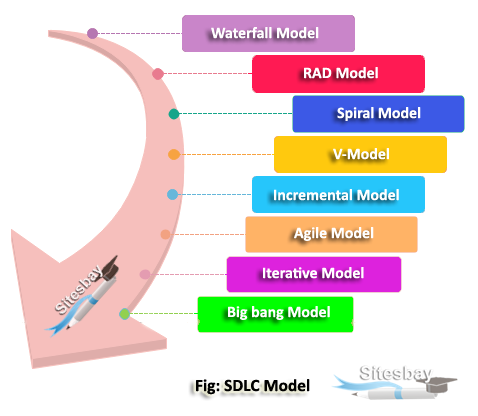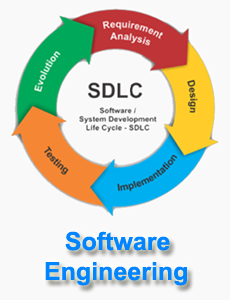What is SDLC Model
Software Development Life Cycle Model
Software Development life cycle (SDLC) is a spiritual model used in project management that defines the stages include in an information system development project, from an initial feasibility study to the maintenance of the completed application.

There are different software development life cycle models specify and design, which are followed during the software development phase. These models are also called "Software Development Process Models." Each process model follows a series of phase unique to its type to ensure success in the step of software development.
- Waterfall Model
- RAD Model
- Spiral Model
- V-Model
- Incremental Model
- Agile Model
- Iterative Model
- Big bang model
- Prototype Model
Waterfall Model: This model has five phases: Requirements analysis and specification, design, implementation, and unit testing, integration and system testing, and operation and maintenance. The steps always follow in this order and do not overlap. The developer must complete every phase before the next phase begins. This model is named "Waterfall Model", because its diagrammatic representation resembles a cascade of waterfalls.
RAD Model: RAD model is Rapid Application Development model. It is a type of incremental model. In RAD model the components or functions are developed in parallel as if they were mini projects. The developments are time boxed, delivered and then assembled into a working prototype.
Spiral Model: Spiral model is one of the most important Software Development Life Cycle models, which provides support for Risk Handling. In its diagrammatic representation, it looks like a spiral with many loops. The exact number of loops of the spiral is unknown and can vary from project to project. Each loop of the spiral is called a Phase of the software development process.
V-Model: V Model is a highly disciplined SDLC model in which there is a testing phase parallel to each development phase. The V model is an extension of the waterfall model in which testing is done on each stage parallel with development in a sequential way. It is known as the Validation or Verification Model.
Incremental Model: In incremental model the whole requirement is divided into various builds. Multiple development cycles take place here, making the life cycle a "multi-waterfall" cycle. Cycles are divided up into smaller, more easily managed modules. Incremental model is a type of software development model like V-model, Agile model etc.
Agile Model: Agile development model is also a type of Incremental model. Software is developed in incremental, rapid cycles. This results in small incremental releases with each release building on previous functionality. Each release is thoroughly tested to ensure software quality is maintained. It is used for time critical applications.
Iterative Model: An iterative life cycle model does not attempt to start with a full specification of requirements. Instead, development begins by specifying and implementing just part of the software, which can then be reviewed in order to identify further requirements. This process is then repeated, producing a new version of the software for each cycle of the model.
Big bang model: The Big Bang Model is popular in situations or adopted when the project's stakeholders or customers are not certain regarding their wants and requirements. They have also haven't analyzed all the essential features and characteristics that they plan to incorporate into their system. In this model, all or most of the requirements are understood and put into practice as they begin developing the prototype.
Prototype Model: The basic idea in Prototype model is that instead of freezing the requirements before a design or coding can proceed, a throwaway prototype is built to understand the requirements. This prototype is developed based on the currently known requirements. Prototype model is a software development model. By using this prototype, the client can get an "actual feel" of the system, since the interactions with prototype can enable the client to better understand the requirements of the desired system. Prototyping is an attractive idea for complicated and large systems for which there is no manual process or existing system to help determining the requirements.
Which SDLC methodology is right for you?
Each of these SDLC methodologies offers unique process for the variety of project challenges you will encounter in your career. Finding the right one depends heavily on not just the expected outcome, but the parameters by which the project is executed.

